|
Amongst
all of the pageantry, celebration, and promotion of the latest
short magnums, which have become the darlings of the gun
industry during the past few years, Winchester has
quietly and without fanfare reintroduced the good old .25-35
into their lever action rifle line. The .25-35 was first
introduced back in 1895 in Winchester’s model 1894 rifle.
Considered a pretty hot cartridge back then, it has slowly faded
to obscurity, with no American made rifles being produced in
this chambering for well over fifty years, until now. The .25-35
earned a respected reputation on game over 100 years ago, but
has since been overshadowed by excellent twenty-five caliber
cartridges such as the .257 Roberts, .250-3000 Savage, and the
.25-06 Remington. With the recent introduction of the .25
Winchester Super Short Magnum (WSSM), I was both surprised and
ecstatic when I heard of the reintroduction of the .25-35 into
the Model 94. Winchester Ammunition has kept the .25-35
ammo in production, along with RWS in Europe, where the
cartridge is known as the 6.5x52Rmm, over the past few decades.
I hear that the .25-35 is still pretty popular in Canada and
Alaska , where locals use it for everything from seal to moose
quite successfully. However, here in the original forty-eight
states, the cartridge has all but died a slow lingering death,
which is a sad thing for such a dandy of a cartridge.
While the only factory load available for the
.25-35 recently has been the 117 grain Winchester Super-X Soft
Point at 2230 feet-per-second (fps). That is a very good loading
for the old cartridge, but hand loading the .25 WCF offers much
more versatility for a variety of game. A bit more on that
later.
Upon hearing of the reintroduction of the .25-35
in the Model 94, I immediately began to pester Paul
Thompson of Browning/Winchester for a sample
rifle for review. Winchester chambers the .25-35 in their Trails
End Hunter variation of the Model 94, in both octagon and
round barreled versions. The one received for testing was the
latter. The Trails End rifles are built with features
reminiscent of the older Winchester carbines and short rifles,
with different forend wood and sights than the regular Model 94
carbines. The twenty inch round barrel tapers to a slender
.605 inch diameter at the muzzle, and the forend is attached
with the traditional barrel band. The overall length measures
thirty-eight and one-eighth inches, with a thirteen and
three-eighths length of pull. The trigger pull measured four
pounds and eleven ounces, and had a crisp release after the
customary Model 94 slack was taken up. The Trails End Hunter,
like all new Model 94 Winchesters, has a top tang sliding safety
that blocks the hammer from contacting the firing pin when in
its rearward position. While I prefer the traditional Model 94
action without a thumb safety, this is a great improvement over
the crossbolt safety that Winchester used on the 94 for many
years. I was thankful to see that ugly abomination go away. The
new sliding tang safety is also much easier to use than was the
crossbolt, especially for a left-hander like myself. The Trails
End Hunter wears a satin finished straight-grained American
walnut stock, and the bluing of the steel parts is nicely done,
without being overly polished, resulting in a subdued finish
that does not shine like a mirror in the sunlight. It is a good
finish for a hunting rifle, and the Model 94 Winchester has been
one of the world’s most popular hunting rifles for well over a
century.
Many hunters today, however, write off the lever
action rifles as being inferior to a bolt action for hunting.
This is a mistake. While many leverguns do not turn in the
excellent mechanical accuracy of today’s best bolt actions,
their practical accuracy is very good for hunting, with many
leverguns turning in bench rested groups that rival the better
bolt guns. The endearing traits that have kept the Model 94
popular for over 110 years still make it an excellent choice for
a hunting rifle. The Model 94 carbine is the definition of
handiness. It balances perfectly, and comes quickly to the
shoulder, like a good bird gun. It is one of John
Browning’s best designs, and it thrives today not out of
nostalgia, but due to its enduring versatility and practicality.
In other words; the Model 94 works, and works well.
Bringing back the .25-35 in the Model 94 is one
of Winchester’s best ideas in years, but one which I find
surprising. The trend towards ever higher pressures and
velocities over the past fifty years makes a cartridge such as
the .25-35 seem almost anemic in comparison. Many wrongly
confuse the .25-35 with the .25-20, and while they share a
common bore diameter, they are very different in power and
application. The .25-35 Winchester is an excellent cartridge for
medium game like whitetail deer and antelope, and also serves
very well as a varmint and predator cartridge with the right
bullet. While the Winchester factory load is a dandy for
deer-sized game, the versatility of the .25-35 can only be
realized by hand loading.
Handload data for the .25-35 is available, but
scarce. Even in my latest edition of the standard reference "Pet
Loads", which is a great source of valuable information
for the handloader, Ken Waters has not reviewed the
.25-35. While his data listed for the .25 Remington can be used
for the .25-35, it still is slim on information needed to
realize the potential of the .25-35. Hodgdon, Hornady,
and Accurate Arms all have load data in their
manuals, but for more information, I turned to my good friend Frank
"Paco" Kelly for the best information that I could
find on the subject. Paco has out a book on CD-ROM that has
priceless information on the .25-35 Winchester, along with reams
of data and info on many other cartridges. He sells this CD for
just under 20 bucks, shipped. It is worth several times that
price, and saved me a great deal of legwork on just this project
alone. I think that a Gunblast review on his book on CD is in
order. Look for it soon. In the meantime, I will list a link to
buy the CD at the bottom of this article. It is the best $20
that I have ever spent for hand loading information.
I had read that cases could be formed easily
from .30-30 brass, but in my dies, that was not the situation.
Case failure was high, no matter how well-lubricated the case.
Therefore, I used factory .25-35 brass for all loads tested,
giving up on the case-forming.
Working up handloads for the .25-35, I found
that one of the best powders for improved performance in this
cartridge is AA2460 from Accurate Arms. I found no data at all
for this powder, even from the Accurate Arms data manual.
However, it turned in a stellar performance for velocity and
shot to shot consistency in the test rifle. I also found IMR’s
new Trail Boss powder to be extremely uniform for
low-velocity cast bullet loads for use on small game, and for
wild turkey. The Mount Baldy
cast 100 grain flat point bullet wears a gas check, and can be
pushed to well over 2400 feet per second without leading for
deer, but is an excellent choice for low velocity loads punching
pencil-sized holes through a turkey without ruining very much
meat. I would much rather have a clean hole through a turkey
breast than several number four lead shot imbedded in the meat.
The table below lists a few of the loads tested in the Trails
End Hunter. However, I have pressure tested none of these loads.
They proved safe in my rifle, giving no signs of excessive
pressure, but may not be safe in your firearm. I am not
recommending that you try these loads in your rifle, just
reporting that which worked well for me. Now, after covering my
butt as best as I could, the velocities listed below are in
feet-per-second, and powder charge weights are listed in grains.
Primers were Federal 210M bench rest. All chronograph
data was recorded using a PACT chronograph, with weather
conditions of low humidity and an air temperature of 55 degrees
Fahrenheit.
| Case |
Bullet |
Powder |
Charge |
Velocity |
| Remington |
Hornady 117-grain RN |
IMR 3031 |
26.5 |
2274 |
| Winchester |
Mt. Baldy 110-grain FPGC |
IMR 3031 |
27 |
2393 |
| Winchester |
Remington 86-grain RN |
AA2460 |
29.4 |
2776 |
| Winchester |
Sierra 75-grain HP |
AA2460 |
30.1 |
2906 |
| Winchester |
Hornady 117-grain RN |
AA2460 |
27.5 |
2471 |
| Winchester |
Mt. Baldy 110-grain FPGC |
Titegroup |
5.5 |
1383 |
| Winchester |
Mt. Baldy 100-grain FPGC |
IMR Trail Boss |
5.5 |
1153 |
| Winchester |
117-grain soft point |
Factory Load |
NA |
2135 |
Exceptionally uniform velocities were received
with the load using 27.5 grains of AA2460 powder and Hornady
117 Round Nose bullets. The extreme spread on this load was only
12.8 fps, with an average deviation (AD) of only 5.1! On the low
end of the velocity scale, the load using 5.5 grains of Trail
Boss powder with the Mt. Baldy 100 grain Flat Point Gas Check
bullet had an extreme spread of only 18.8 fps and an AD of only
6! This is amazing load consistency in a rifle cartridge. On the
other hand, I found that IMR 3031 did not work well with the Mt.
Baldy bullet, having excessive velocity variation. 3031 also
failed to meet my velocity expectations with the 117 and 86
grain bullets, showing excessive pressure signs before
delivering expected velocities. I intend to work more with the
AA2460 powder, as the results so far have been very pleasing,
turning in high, consistent velocities with normal pressure
signs. I also want to point out that the load using the 75
grain Sierra bullet should not be loaded end to end into a
tubular magazine. With this load, I place one in the chamber and
one in the magazine tube, for a total of two shots.
While I really like the open sights on the
Trails End Hunter, for accuracy testing and for hunting, I
prefer a good scope, such as the compact four power shown in the
photo. The .25-35 is not a short-range cartridge as many
claim it to be, and can benefit from a good scope sight. With
the bullet matched to the game, the .25-35 kills just as well as
any of the hotter .25 caliber rounds, it just does not have as
flat of a trajectory. For instance, with a 117 grain bullet and
sighted in at 200 yards, the slower round nose .25-35 bullet
drops 4.8 inches at 300 yards as opposed to a spitzer 117 grain
bullet from a .25-06 which drops only 2.78 inches at 300 yards.
That is only a two inch difference, yet the .25-06 is highly
regarded as a flat-shooting deer cartridge, and some misinformed
shooters regard the .25-35 as only suitable for small vermin at
close range. Makes no sense to me. Those who have actually used
the .25-35 on game know that its performance on medium game is
as good as the shooter, and a good scope takes advantage of its
ability much better than iron sights, at least for my eyes.
I also find a scope handy for long shots at small targets, such
as crows and other vermin.
I used Millet bases and rings on the
Model 94, and as I have found in the past, the rear base screws
need to be shortened by one thread to keep from binding the bolt
on the rifle. I have had to do this every time that I have
mounted a scope on an Angle Eject 94 using Millet bases.
The Winchester Trails End Hunter displayed very
good accuracy. I tried several different loads, and all
performed well. The factory 117 grain round nose did
exceptionally well, as can be seen in the photo.
I am very glad that Winchester decided to
chamber the .25-35 again, and it has nothing to do with
nostalgia. We have plenty of cartridges for that. The .25-35
offers good accuracy, very mild recoil, and plenty of power. The
bullets that are suitable for the .25-35 are made to perform
well at its moderate velocities. The 117 grain Hornady and
Winchester bullets will expand on game, but not come apart as
they might if driven to magnum speeds. The Winchester carbine
uses a one-in-eight twist to stabilize the long bullets, and the
long bullets at moderate speeds ensure good penetration. They
have plenty of killing power, yet you won’t have half of the
meat bloodshot as often happens when shooting deer with magnum
cartridges. I also like the eighty-six grain Remington bullet,
and plan to work with it further, on both deer and vermin. It
should be perfection on coyotes. The Mt. Baldy 100 grain cast
bullet works well at low or high velocity, depending upon the
intended game.
With the reintroduction of the great old .25-35
in the Model 94, Winchester has provided yet another excellent
hunting rifle to a new generation of hunters. It is a rifle that
will do for just about anything that I hunt, and do the job
well. If I were heading to Africa for buffalo or to Kodiak
Island for bear, I would bring a bigger rifle, but for pure
versatility on animals from crow to whitetail, the .25-35 will
do just fine. Thanks, Winchester.
For more information on Winchester’s line of
quality firearms, go to: www.winchester-guns.com.
For a look at the entire line of Winchester
ammunition, go to: www.winchester.com.
To order the excellent cast bullets from Mt.
Baldy, go to: www.mtbaldybullets.com.
For information on the Hornady and Sierra
bullets, check out their websites at: www.hornady.com
and www.www.sierrabullets.com.
To order Paco Kelly’s excellent book on CD,
"Lever and Hand Guns", click here:
http://www.leverguns.com/store/paco_order.htm.
Jeff Quinn
|
To find a Winchester Firearms dealer
in your area, click here: |
|

|
  
Got something to say about this article? Want to agree (or
disagree) with it? Click the following link to go to the GUNBlast Feedback Page.
|
|
Click pictures for a larger version.
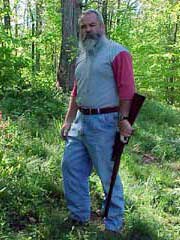
Author with Winchester's new Trails End Hunter rifle,
chambered in .25-35.
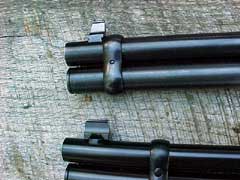

Difference in front sights and forend wood between the
standard Model 94 (top) and Trails End Hunter (bottom).
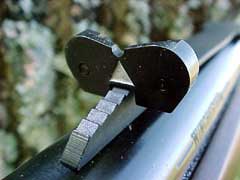
Rear sight of the Trails End Hunter offers a very nice
sight picture for those who prefer iron sights to a scope
sight.
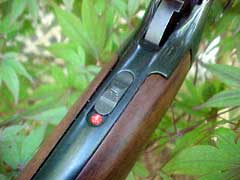
Top tang safety featured on the new Model 94 line is a
great improvement over the old crossbolt style.
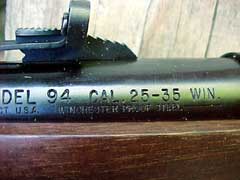
It's been a long time since we've seen this marking on a
new Winchester barrel.
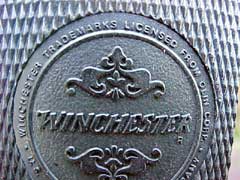
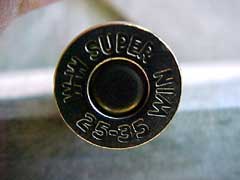
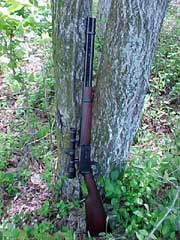
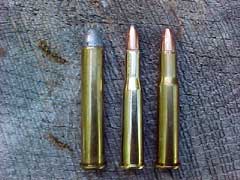
Left to right: .38-55, .25-35 and .30-30 all use the
same basic case.
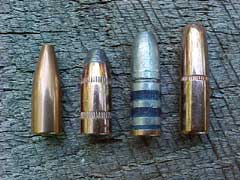
Bullets for the .25-35 include (left to right): 75-grain
Sierra hollow point, 86-grain Remington soft point, 100-grain
Mt. Baldy flat point gas check, 117-grain Hornady soft point.
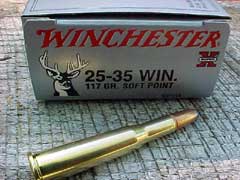
Winchester offers some excellent factory loads for the
.25-35, but the full potential of this great cartridge is
realized by handloading.
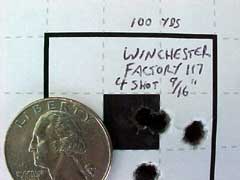
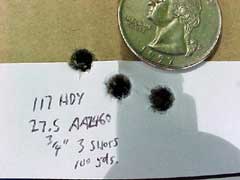

Groups produced by the test rifle with a variety of
loads prove the excellence of both the .25-35 cartridge and
the Winchester Trails End Hunter rifle.
|
![]()